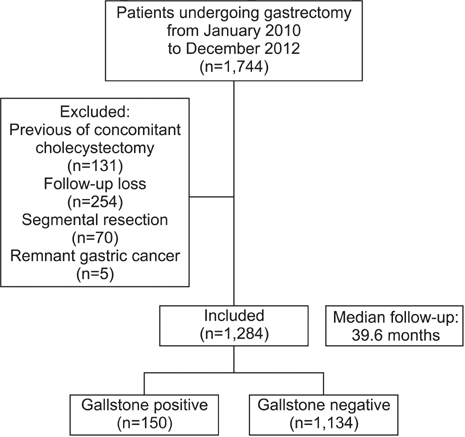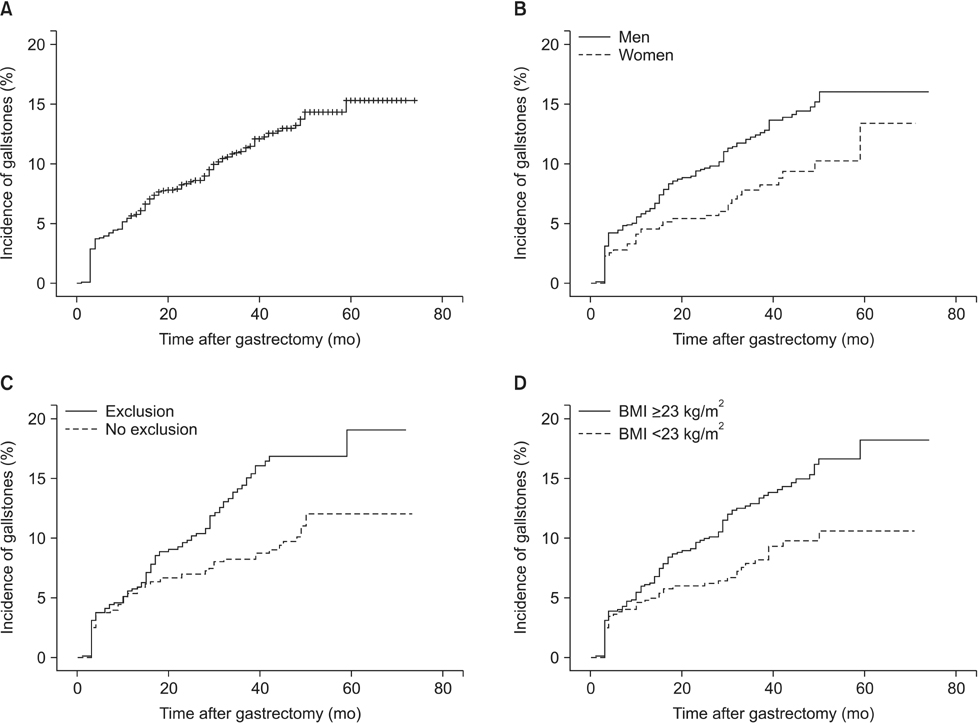J Gastric Cancer.
2016 Jun;16(2):98-104. 10.5230/jgc.2016.16.2.98.
Risk Factors for Gallstone Formation after Surgery for Gastric Cancer
- Affiliations
-
- 1Department of Surgery, Seoul National University Bundang Hospital, Seongnam, Korea. djpark@snubh.org
- 2Department of Surgery, Seoul National University College of Medicine, Seoul, Korea.
- KMID: 2328076
- DOI: http://doi.org/10.5230/jgc.2016.16.2.98
Abstract
- PURPOSE
The incidence of gallstones after gastrectomy for gastric cancer is higher than in the general population. However, the causes and mechanisms of post-gastrectomy gallstones are unclear. The aim of this study was to evaluate the incidence of gallstone formation and the risk factors for their development after gastrectomy for gastric cancer.
MATERIALS AND METHODS
Of 1,744 gastric cancer patients who underwent gastrectomy at Seoul National University Bundang Hospital between January 2010 and December 2012, 1,284 were included in this study and retrospectively reviewed. Patients' age, sex, body mass index (BMI), tumor location, stage, type of gastrectomy, type of reconstruction, and extent of node dissection were evaluated.
RESULTS
The incidence of gallstones after gastrectomy for gastric cancer was significantly higher in men than in women (P=0.019). Exclusion of the duodenum during reconstruction was associated with a significantly higher incidence of gallstones (P=0.003). Overweight and obese patients with BMI ≥23 kg/m2 had significantly higher incidence of gallstones than those with a lower BMI (P=0.006). Multivariate analysis showed that obesity (hazard ratio, HR=1.614; 95% confidence interval, CI: 1.135~2.296; P=0.008), male sex (HR=1.515, 95% CI: 1.029~2.231, P=0.033), and exclusion of the duodenum (HR=1.648, 95% CI: 1.192~2.280, P=0.003) were significant, independent risk factors for gallstones after gastrectomy.
CONCLUSIONS
The cumulative incidence of gallstones for 5 years after gastrectomy was 15.3%. Male sex, obesity, and exclusion of the duodenum were risk factors for gallstone formation after gastrectomy. Careful surveillance will be required for these patient groups after gastrectomy.
Keyword
MeSH Terms
Figure
Cited by 1 articles
-
Incidence of gallstones after gastric resection for gastric cancer: a nationwide claims-based study
Gi Hyeon Seo, Chang-Sup Lim, Young Jun Chai
Ann Surg Treat Res. 2018;95(2):87-93. doi: 10.4174/astr.2018.95.2.87.
Reference
-
1. Hwang JY, Lee JH, Chi KC, Park SI. Clinical review of cholelithiasis after gastric resection in gastric cancer patients. J Korean Surg Soc. 2004; 67:198–203.2. Kobayashi T, Hisanaga M, Kanehiro H, Yamada Y, Ko S, Nakajima Y. Analysis of risk factors for the development of gallstones after gastrectomy. Br J Surg. 2005; 92:1399–1403.3. Fukagawa T, Katai H, Saka M, Morita S, Sano T, Sasako M. Gallstone formation after gastric cancer surgery. J Gastrointest Surg. 2009; 13:886–889.4. Chen XJ, Li N, Huang YD, Ren S, Liu F, Chen L, et al. Factors for postoperative gallstone occurrence in patients with gastric cancer: a meta-analysis. Asian Pac J Cancer Prev. 2014; 15:877–881.5. Jun KH, Kim JH, Kim JJ, Chin HM, Park SM. Retrospective analysis on the gallstone disease after gastrectomy for gastric cancer. Gastroenterol Res Pract. 2015; 2015:827864.6. Inoue K, Fuchigami A, Hosotani R, Kogire M, Huang YS, Miyashita T, et al. Release of cholecystokinin and gallbladder contraction before and after gastrectomy. Ann Surg. 1987; 205:27–32.7. Hahm J, Park J, Cho Y, Eun C, Lee Y, Choi H, et al. Changes in gallbladder motility in gastrectomized patients. Korean J Intern Med. 2000; 15:19–24.8. Yi SQ, Ohta T, Tsuchida A, Terayama H, Naito M, Li J, et al. Surgical anatomy of innervation of the gallbladder in humans and Suncus murinus with special reference to morphological understanding of gallstone formation after gastrectomy. World J Gastroenterol. 2007; 13:2066–2071.9. Chang YR, Jang JY, Kwon W, Park JW, Kang MJ, Ryu JK, et al. Changes in demographic features of gallstone disease: 30 years of surgically treated patients. Gut Liver. 2013; 7:719–724.10. Nakamura K, Ogoshi K, Makuuchi H. Clinicopathological study of cholelithiasis following gastric cancer surgery. Eur Surg Res. 2005; 37:29–35.11. Akatsu T, Yoshida M, Kubota T, Shimazu M, Ueda M, Otani Y, et al. Gallstone disease after extended (D2) lymph node dissection for gastric cancer. World J Surg. 2005; 29:182–186.12. Sugita H, Kojima K, Inokuchi M, Kato K. Long-term outcomes of laparoscopic gastrectomy for gastric cancer. J Surg Res. 2015; 193:190–195.13. Unisa S, Jagannath P, Dhir V, Khandelwal C, Sarangi L, Roy TK. Population-based study to estimate prevalence and determine risk factors of gallbladder diseases in the rural Gangetic basin of North India. HPB (Oxford). 2011; 13:117–125.14. Stender S, Nordestgaard BG, Tybjaerg-Hansen A. Elevated body mass index as a causal risk factor for symptomatic gallstone disease: a Mendelian randomization study. Hepatology. 2013; 58:2133–2141.15. Radmard AR, Merat S, Kooraki S, Ashraf M, Keshtkar A, Sharafkhah M, et al. Gallstone disease and obesity: a population-based study on abdominal fat distribution and gender differences. Ann Hepatol. 2015; 14:702–709.16. Aune D, Norat T, Vatten LJ. Body mass index, abdominal fatness and the risk of gallbladder disease. Eur J Epidemiol. 2015; 30:1009–1019.17. Tsai CJ, Leitzmann MF, Willett WC, Giovannucci EL. Weight cycling and risk of gallstone disease in men. Arch Intern Med. 2006; 166:2369–2374.18. Nomura H, Kashiwagi S, Hayashi J, Kajiyama W, Ikematsu H, Noguchi A, et al. Prevalence of gallstone disease in a general population of Okinawa, Japan. Am J Epidemiol. 1988; 128:598–605.19. Heaton KW, Braddon FE, Mountford RA, Hughes AO, Emmett PM. Symptomatic and silent gall stones in the community. Gut. 1991; 32:316–320.20. Sun H, Tang H, Jiang S, Zeng L, Chen EQ, Zhou TY, et al. Gender and metabolic differences of gallstone diseases. World J Gastroenterol. 2009; 15:1886–1891.21. Ando S, Tsuji H. Surgical technique of vagus nerve-preserving gastrectomy with D2 lymphadenectomy for gastric cancer. ANZ J Surg. 2008; 78:172–176.22. Inokuchi M, Sugita H, Otsuki S, Sato Y, Nakagawa M, Kojima K. Long-term effectiveness of preserved celiac branch of vagal nerve after Roux-en-Y reconstruction in laparoscopy-assisted distal gastrectomy. Dig Surg. 2014; 31:341–346.
- Full Text Links
- Actions
-
Cited
- CITED
-
- Close
- Share
- Similar articles
-
- Risk Factors for Gallbladder Stone Formation after Gastric Cancer Surgery
- Incidence of gallstones after gastric resection for gastric cancer: a nationwide claims-based study
- Prevention of Gallstones After Bariatric Surgery using Ursodeoxycholic Acid: A Narrative Review of Literatures
- Cholelithiasis as a Risk Factor for Gallbladder Cancer
- Risk Factors of Gastric Cancer and Lifestyle Modification for Prevention



